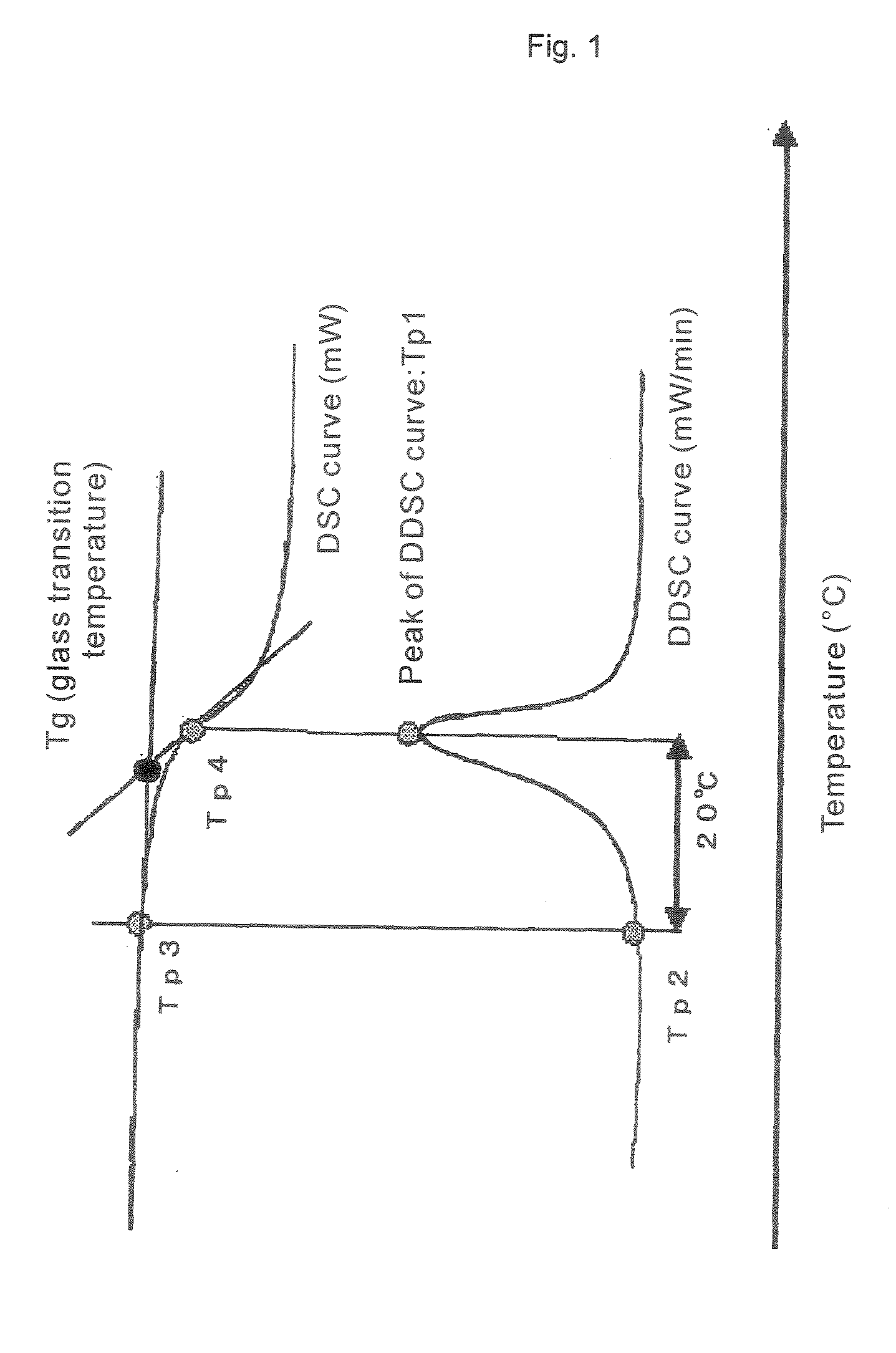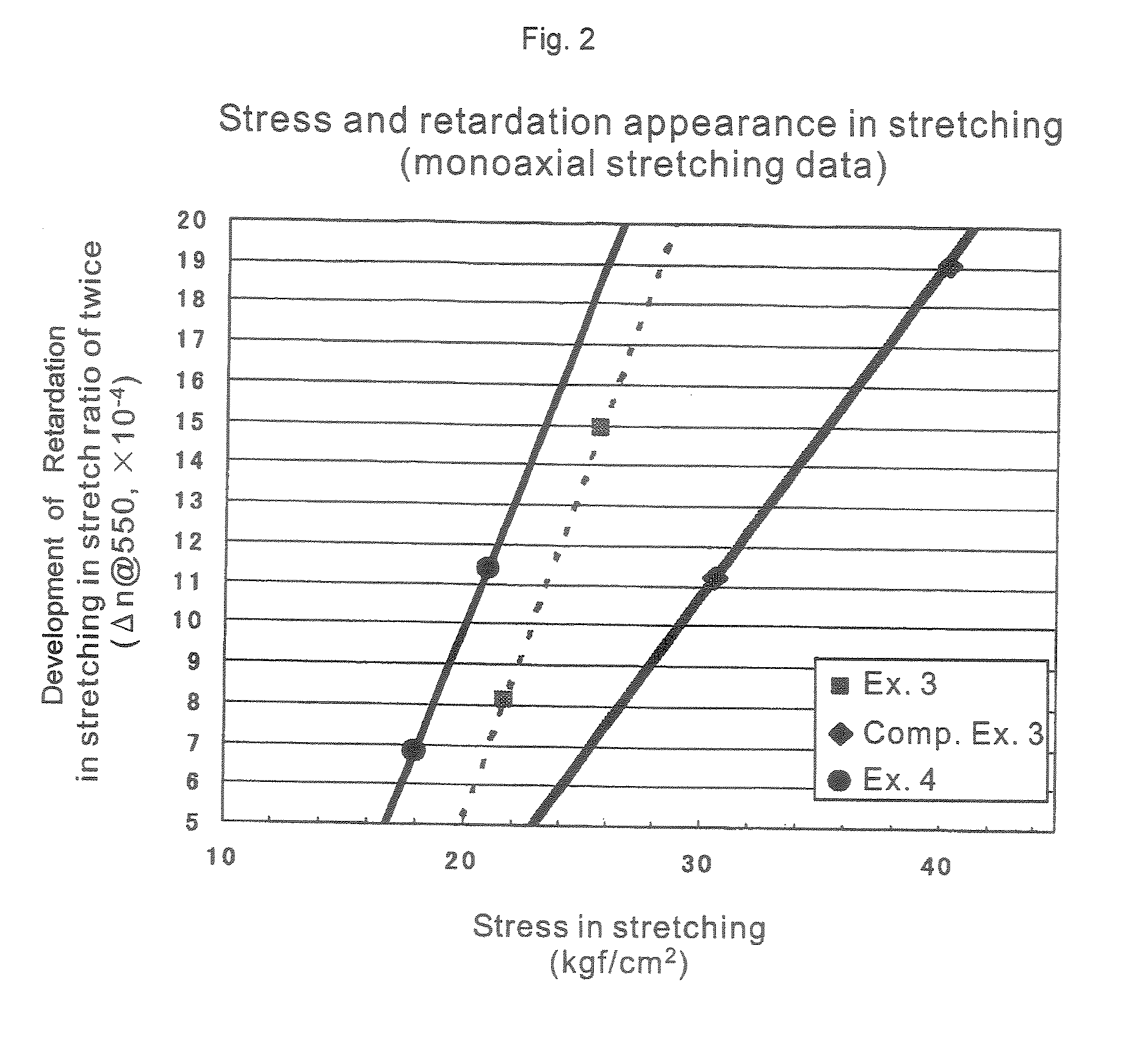Thermoplastic Resin Composition and Optical Films Made Therefrom
a technology of thermoplastic resin and composition, which is applied in the direction of optical elements, instruments, transportation and packaging, etc., can solve the problems of difficult thinning of thermoplastic film that has been desired in recent years, difficult to obtain a retardation film having a function, and poor heat resistance and optical properties, so as to maintain wavelength dispersion properties, improve the development of thermoplastic film, and improve the effect of retardation
- Summary
- Abstract
- Description
- Claims
- Application Information
AI Technical Summary
Benefits of technology
Problems solved by technology
Method used
Image
Examples
synthesis example 1
[0242] In a reaction vessel purged with nitrogen, 20 g of 8-methoxycarbonyl-8-methyltetracyclo[4.4.0.12,5.17,10]-3-dodecene represented by the following formula (A), 5.0 g of 5-methoxycarbonyl-5-methylbicyclo[2.2.1]hept-2-ene represented by the following formula (B), 1.2 g of 1-hexene as a molecular weight modifier and 86.3 g of toluene were placed, and they were heated to 80° C. Then, 0.15 ml of a toluene solution of triethylaluminum (0.61 mol / l) and 0.47 ml of a toluene solution of methanol-modified WCl6 (0.025 mol / l) were added, and reaction was performed at 80° C. for 3 hours to give a polymer. Subsequently, the resulting ring-opened copolymer solution was placed in an autoclave, and 86.3 g of toluene was further added. Then, RuHCl(CO)[P(C6H5)]3 as a hydrogenation catalyst was added in an amount of 2500 ppm based on the amount of the monomers charged, and the hydrogen gas pressure was adjusted to 9 to 10 MPa, followed by reaction at 160 to 165° C. for 3 hours. After the reaction...
synthesis example 2
[0243] In a reaction vessel purged with nitrogen, 50 g of 8-methoxycarbonyl-8-methyltetracyclo[4.4.0.12,5.17,10]-3-dodecene represented by the above formula (A), 2.3 g of 1-hexene as a molecular weight modifier and 100 g of toluene were placed, and they were heated to 80° C. Then, 0.09 ml of a toluene solution of triethylaluminum (0.6 mol / l) and 0.29 ml of a toluene solution of methanol-modified WCl6 (0.025 mol / l) were added, and reaction was performed at 80° C. for 3 hours to give a polymer Subsequently, the resulting ring-opened copolymer solution was placed in an autoclave, and 100 g of toluene was further added. Then, RuHCl(CO)[P(C6H5)]3 as a hydrogenation catalyst was added in an amount of 2500 ppm based on the amount of the monomers charged, and the hydrogen gas pressure was adjusted to 9 to 10 MPa, followed by reaction at 160 to 165° C. for 3 hours. After the reaction was completed, the reaction product was precipitated in a large amount of a methanol solution to give a hydro...
synthesis example 3
[0244] In a reaction vessel, 101 ml of styrene, 4.5 g of α-methyl-p-hydroxystyrene, 5.0 ml of acrylonitrile and 0.6131 g of 2,2′-azobis(2,4-dimethylvaleronitrile) Wako reagent: V-65) were placed. A stream of nitrogen was bubbled for 10 minutes, and then reaction was performed at 55° C. for 7 hours. After the react-on was completed, the reaction product was reprecipitated in a large amount of methanol to give a styrene / α-methyl-p-hydroxystyrene / acrylonitrile copolymer. The resulting vinyl-based polymer (resin (B1)) had Tg of 110° C., a weight-average molecular weight (Mw) of 7.27×104 and a molecular weight distribution (Mw / Mn) of 1.81.
PUM
| Property | Measurement | Unit |
|---|---|---|
| glass transition temperature | aaaaa | aaaaa |
| glass transition temperature | aaaaa | aaaaa |
| ¼ wavelength | aaaaa | aaaaa |
Abstract
Description
Claims
Application Information
 Login to View More
Login to View More - R&D
- Intellectual Property
- Life Sciences
- Materials
- Tech Scout
- Unparalleled Data Quality
- Higher Quality Content
- 60% Fewer Hallucinations
Browse by: Latest US Patents, China's latest patents, Technical Efficacy Thesaurus, Application Domain, Technology Topic, Popular Technical Reports.
© 2025 PatSnap. All rights reserved.Legal|Privacy policy|Modern Slavery Act Transparency Statement|Sitemap|About US| Contact US: help@patsnap.com



